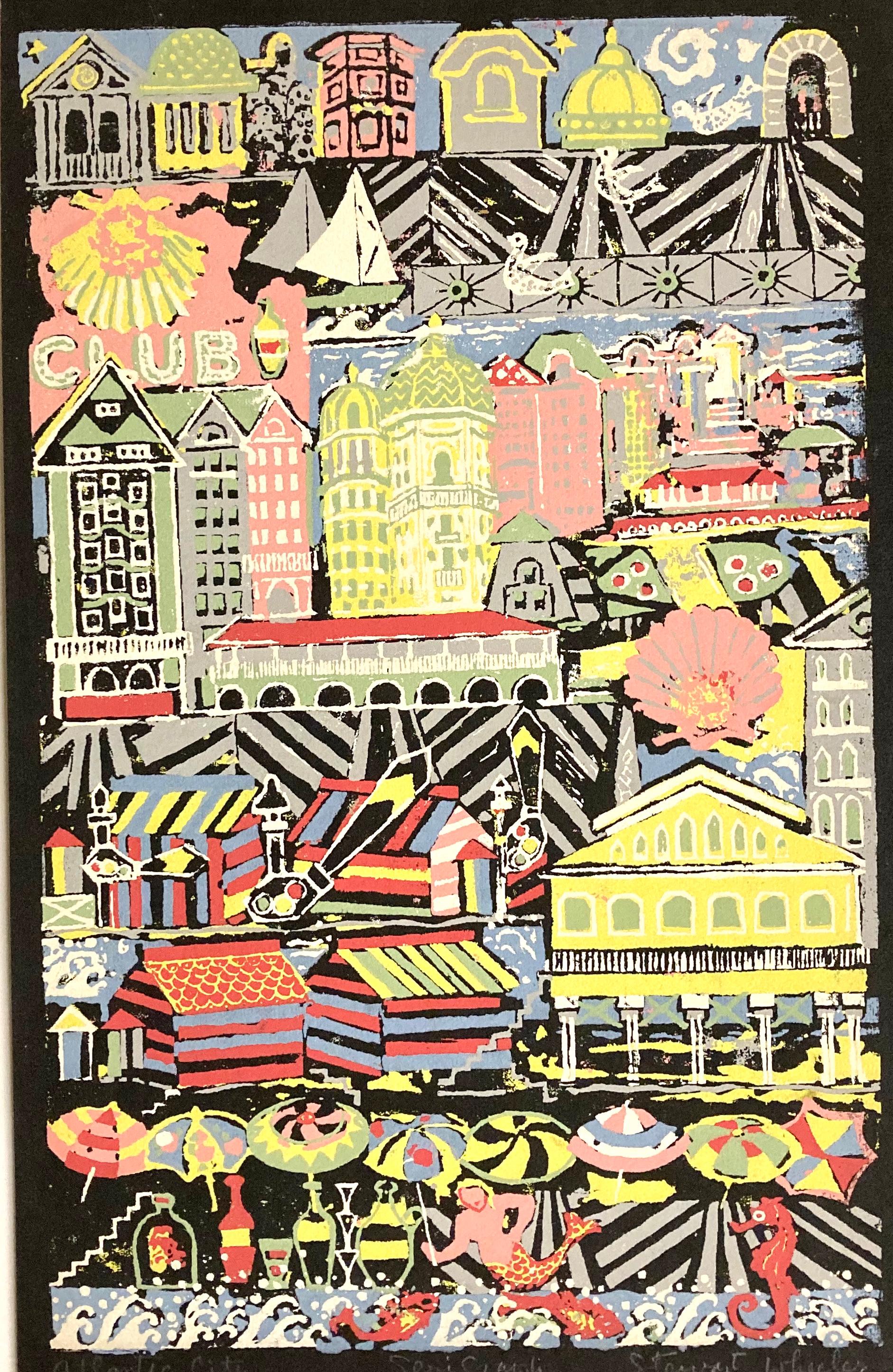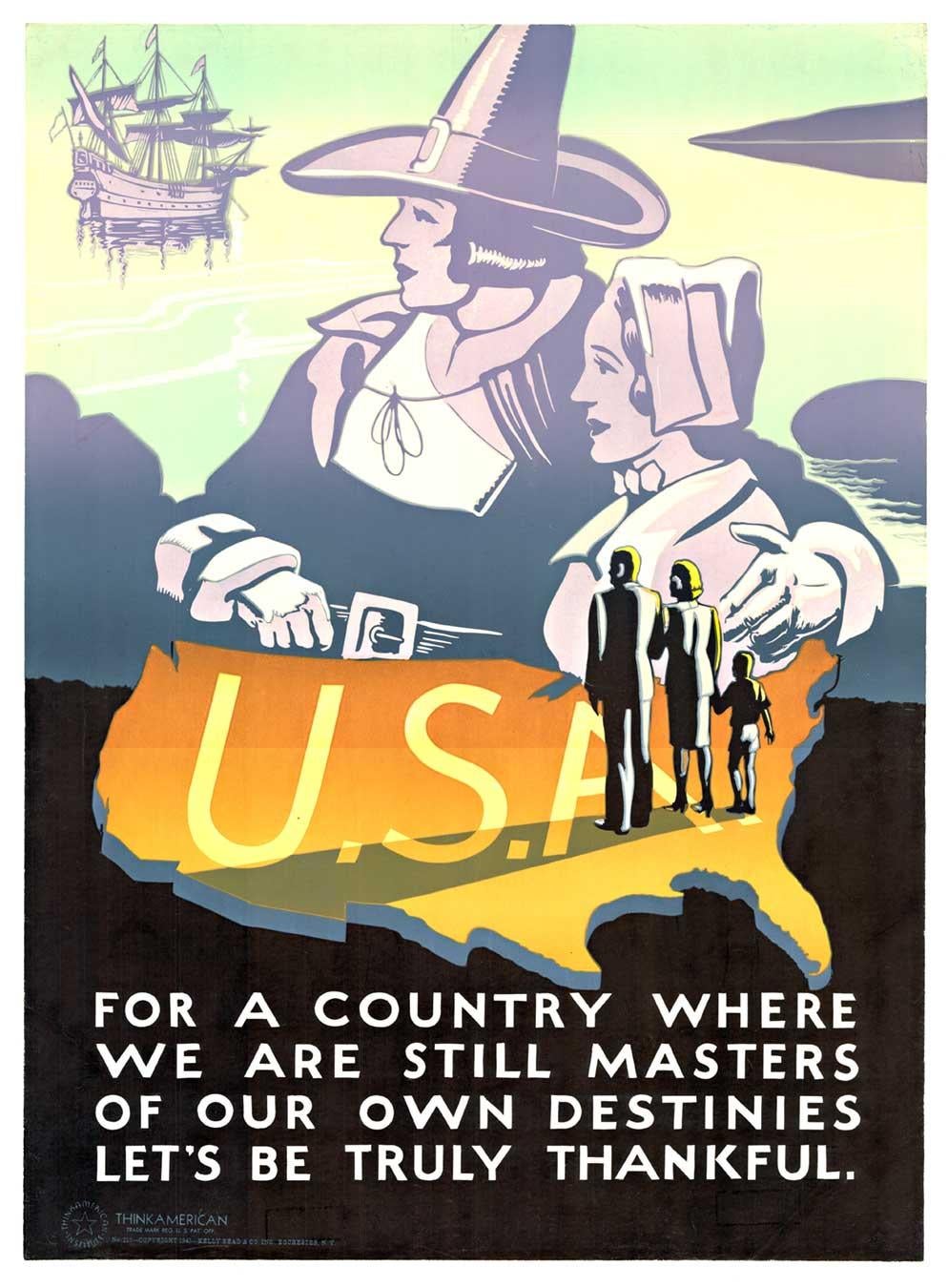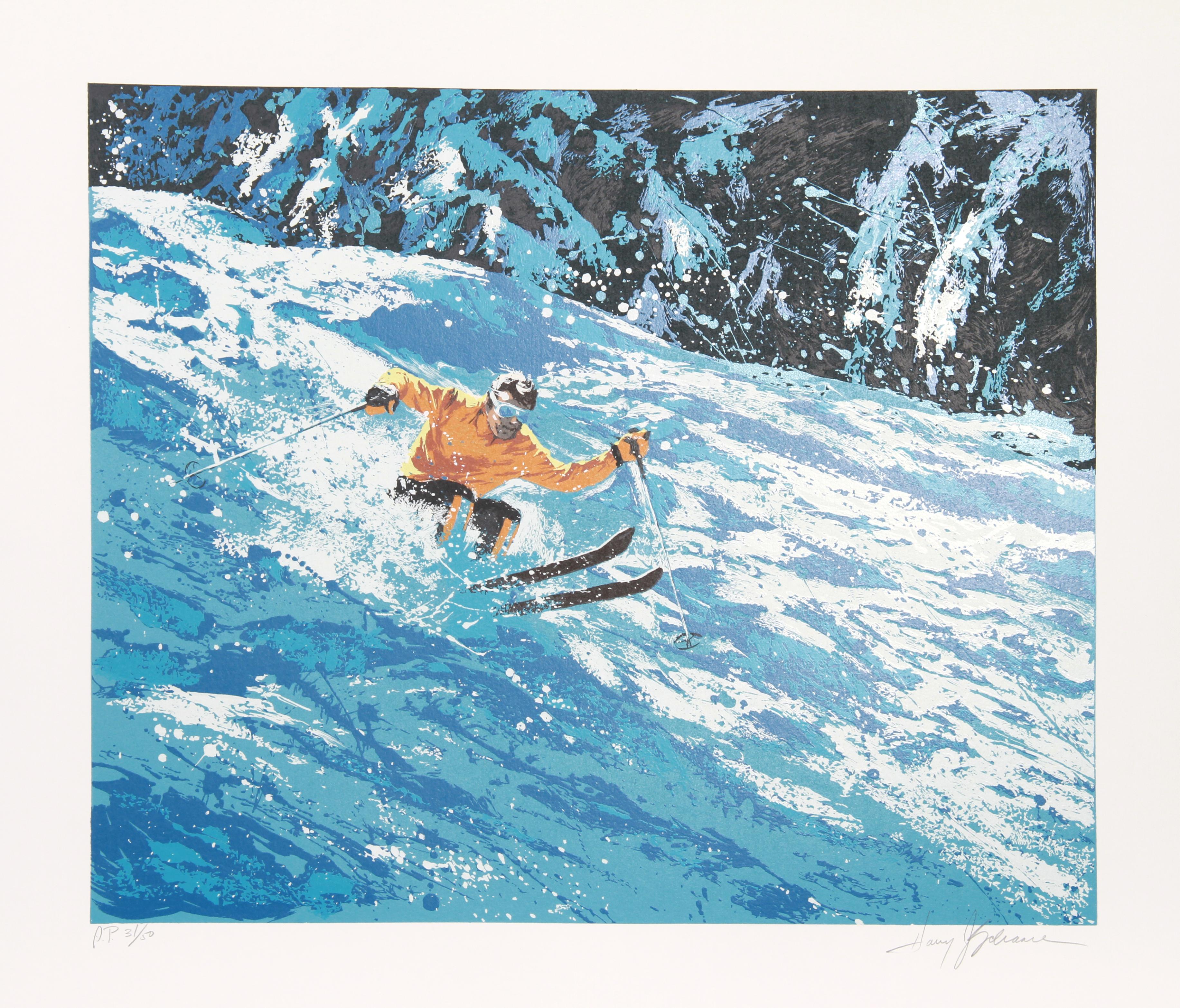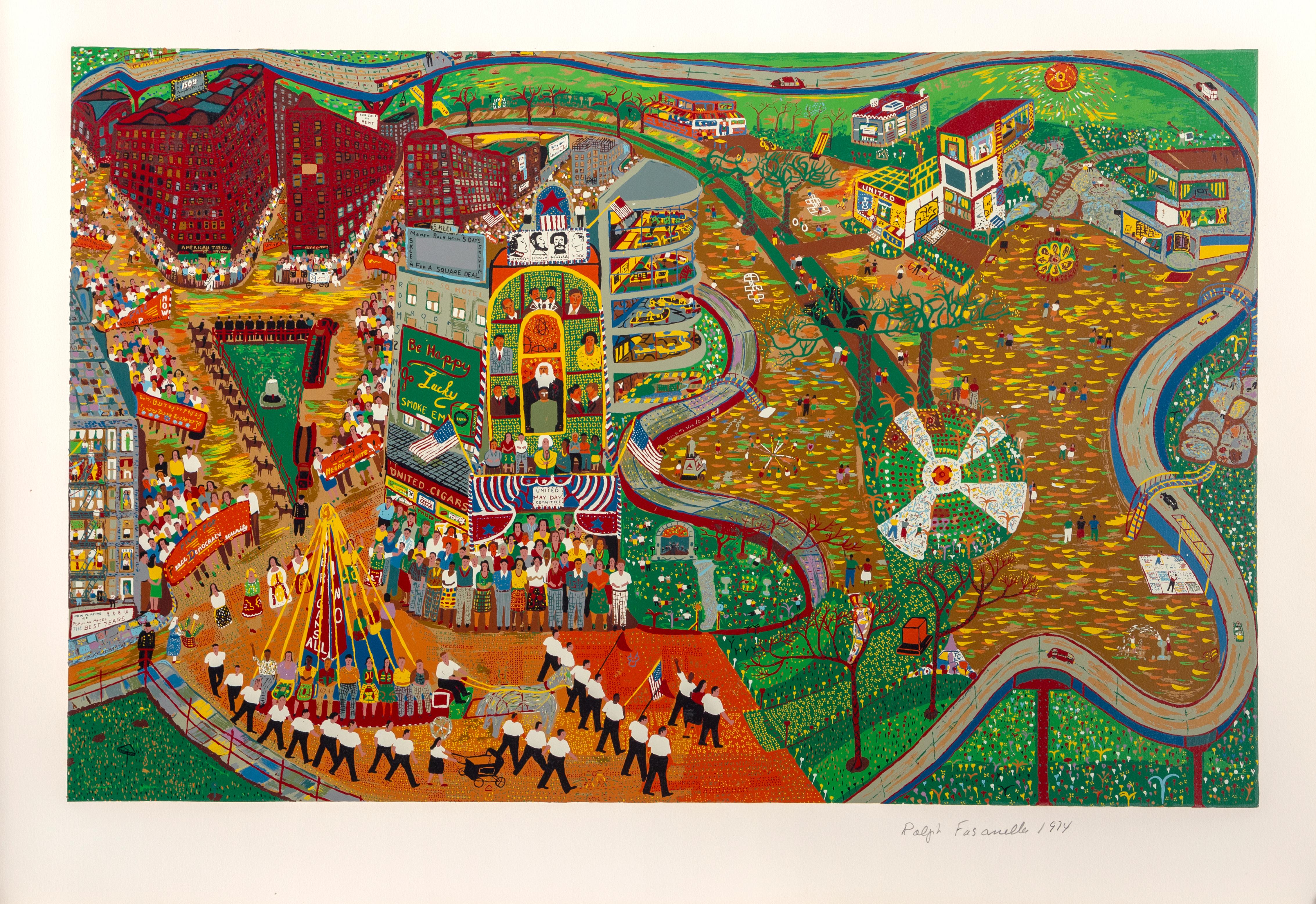Items Similar to 'The French Farm' — Mid-Century Modernism
Want more images or videos?
Request additional images or videos from the seller
1 of 8
Edward August Landon'The French Farm' — Mid-Century Modernism1942
1942
About the Item
Edward Landon, 'The French Farm', color serigraph, 1942, Ryan 86. Signed, titled, and annotated 'Edition 50' in pencil. A superb impression, with fresh colors, on cream, wove paper; the full sheet with margins (1 1/4 to 1 5/8 inches), in excellent condition. Matted to museum standards, unframed.
Image size 12 x 18 inches (305 x 457 mm); sheet size 15 x 21 inches (381 x 533 mm).
An impression of this work is in the permanent collection of the National Gallery of Art, Washington, DC.
ABOUT THE ARTIST
Born in Hartford, Connecticut, Edward Landon dropped out of high school to study art at the Hartford Art School. In 1930 and 1931, he was a student of Jean Charlot at the Art Students League in New York, after which he traveled to Mexico to study privately for a year with Carlos Merida. In 1933 he settled near Springfield, Massachusetts, painted murals in the local trade school, and exhibited with the Springfield Art League. His painting 'Memorial Day' won first prize at the fifteenth annual exhibition of the League at the Springfield Museum of Fine Arts. Landon became an active member of the Artists Union of Western Massachusetts, serving as president from 1934-1938.
Landon acquired Anthony Velonis’s instructional pamphlet on the technique of serigraphy in the late 1930s. With colleagues Phillip Hicken, Donald Reichert, and Pauline Stiriss, he began experimenting with screen printing techniques. The artists' groundbreaking work in screen printing as a fine art medium was the subject of the group’s landmark exhibition at the Springfield Museum of Fine Arts in 1940.
Landon became one of the founding members of the National Serigraph Society and served as editor of its publication, 'Serigraph Quarterly,' in the late 1940s and as its president in 1952 and 1953. The Norlyst Gallery in Manhattan held a one-person show of his prints in 1945. Awarded a Fulbright Fellowship in 1950, Landon traveled to Norway, where he researched the history of local artistic traditions and produced the book 'Scandinavian Design: Picture and Rune Stones, 1000 B.C. to 1100 A.D.' He also taught serigraphy and organized print exhibitions, including a show of his own work at the Unge Kunstneres Samfund in Oslo. In Stockholm, Sweden, he lectured on serigraphy under the auspices of the United States Information Agency. He exhibited with the National Serigraph Society (1940-60), the American Color Print Society (1945-65), the Boston Printmakers (1955-70), and the Northwest Printmakers (1950-60). The Philadelphia Print Club sponsored a solo show of his work in 1953.
Edward Landon's serigraphs are included in major American and International museum collections: Bibliotheque National, Paris; Moderna Museet, Sweden; Tel Aviv Museum, Israel; Turku Museum, Finland; Victoria and Albert Museum, England; Boston Museum of Fine Arts; British Museum; Carnegie Museum of Art; Cincinnati Museum of Art; Portland Art Museum; Seattle Art Museum; Whitney Museum of American Art; US Library of Congress.
- Creator:Edward August Landon (1911-1984, American)
- Creation Year:1942
- Dimensions:Height: 12 in (30.48 cm)Width: 18 in (45.72 cm)
- Medium:
- Movement & Style:
- Period:
- Condition:
- Gallery Location:Myrtle Beach, SC
- Reference Number:
About the Seller
5.0
Recognized Seller
These prestigious sellers are industry leaders and represent the highest echelon for item quality and design.
Platinum Seller
These expertly vetted sellers are 1stDibs' most experienced sellers and are rated highest by our customers.
Established in 1995
1stDibs seller since 2016
254 sales on 1stDibs
Typical response time: 2 hours
Associations
International Fine Print Dealers Association
- ShippingRetrieving quote...Ships From: Myrtle Beach, SC
- Return PolicyA return for this item may be initiated within 7 days of delivery.
More From This SellerView All
- 'Backyards of Broadway' — 1920s American Precisionism, New York CityBy Louis LozowickLocated in Myrtle Beach, SCLouis Lozowick, 'Backyards of Broadway ( Waterfront I )', lithograph, 1926, edition 10, Flint 7. Signed in pencil. A fine, richly-inked impression, on BFK Rives off-white, wove paper...Category
1920s American Modern Figurative Prints
MaterialsLithograph
- Fountain of Sea Horses, Rome — Early 20th CenturyBy Rudolph RuzickaLocated in Myrtle Beach, SCRudolph Ruzicka, 'Fountain of Sea Horses, Rome', wood engraving, c. 1915. Signed, dated, and titled in pencil. Initialed in the block, lower left. A fine, richly-inked impression, on...Category
1910s American Modern Landscape Prints
MaterialsWoodcut
- 'Hill' — 1930s American ModernismBy Paul LandacreLocated in Myrtle Beach, SCPaul Landacre, 'Hill', wood engraving, 1936, edition 60 (only 54 printed); only 2 impressions printed in a second edition of 150. Signed, titled, and numbered '49/60' in pencil. Wien...Category
1930s American Modern Landscape Prints
MaterialsWoodcut
- 'Financial District', New York City — 1930s American ModernismBy Howard Norton CookLocated in Myrtle Beach, SCHoward Cook, 'Financial District', lithograph, 1931, edition 75, Duffy 155. A fine, richly-inked impression, on cream wove paper, the full sheet with wide margins (2 3/4 to 5 5/8 inches), in excellent condition. Image size 13 5/16 x 10 3/8 inches (338 x 264 mm); sheet size 23 x 16 inches (584 x 406 mm). Matted to museum standards, unframed. Literature: 'American Master Prints from the Betty and Douglas Duffy Collection', the Trust for Museum Exhibitions, Washington, D.C., 1987. Collections: Crystal Bridges Museum of American Art, Library of Congress, Metropolitan Museum of Art, Philadelphia Museum of Art, Smithsonian American Art Museum. ABOUT THE ARTIST Howard Norton Cook (1901-1980) was one of the best-known of the second generation of artists who moved to Taos. A native of Massachusetts, he studied at the Art Students League in New York City and at the Woodstock Art Colony. Beginning his association with Taos in 1926, he became a resident of the community in the 1930s. During his career, he received two Guggenheim Fellowships and was elected an Academician in the National Academy of Design. He earned a national reputation as a painter, muralist, and printmaker. Cook’s work in the print mediums received acclaim early in his career with one-person exhibitions at the Denver Art Museum (1927) and the Museum of New Mexico (1928). He received numerous honors and awards over the years, including selection in best-of-the-year exhibitions sponsored by the American Institute of Graphics Arts, the Brooklyn Museum, the Society of American Etchers, and the Philadelphia Print Club. His first Guggenheim Fellowship took him to Taxco, Mexico in 1932 and 1933; his second in the following year enabled him to travel through the American South and Southwest. Cook painted murals for the Public Works of Art Project in 1933 and the Treasury Departments Art Program in 1935. The latter project, completed in Pittsburgh, received a Gold Medal from the Architectural League of New York. One of his most acclaimed commissions was a mural in the San Antonio Post Office in 1937. He and Barbara Latham settled in Talpa, south of Taos, in 1938 and remained there for over three decades. Cook volunteered in World War II as an Artist War Correspondent for the US Navy, where he was deployed in the Pacific. In 1943 he was appointed Leader of a War Art Unit...Category
1930s American Modern Figurative Prints
MaterialsLithograph
- 'Taos Placita' — 1940s Southwest RegionalismBy Gustave BaumannLocated in Myrtle Beach, SCGustave Baumann, 'Taos Placita', color woodcut, 1947, edition 125. Baumann 132. Signed, titled, and numbered '20-125' in pencil; with the artist’s Hand-in-Heart chop. A superb, richly-inked impression, with fresh colors, on fibrous oatmeal wove paper; the full sheet with margins (2 to 3 1/8 inches); slight rippling at the left sheet edge, in excellent condition. Matted to museum standards, unframed. Image size 9 5/8 x 11 1/4 inches (244 x 286 mm); sheet size 13 1/4 x 17 inches (337 x 432 mm). Collections: New Mexico Museum of Art, Phoenix Art Museum, Wichita Art Museum. ABOUT THE ARTIST Gustave Baumann (1881-1971) was a renowned printmaker and a leading figure of the American color woodcut revival whose exquisite craftsmanship and vibrant imagery captured the essence of the Southwest. "A brilliant printmaker, Baumann brought to the medium a full mastery of the craft of woodworking that he acquired from his father, a German cabinetmaker. This craftsmanship was coupled with a strong artistic training that resulted in the handsome objects we see in the exhibition today. After discovering New Mexico in 1918, Baumann began to explore in his woodblock prints of this period the light. color, and architectural forms of that landscape. His prints of this period are among the most beautiful and poetic images of the American West." —Lewis I. Sharp, Director, Denver Art Museum Baumann, the son of a craftsman, immigrated to the United States from Germany with his family when he was ten, settling in Chicago. From 1897 to 1904, he studied in the evenings at the Art Institute of Chicago, working in a commercial printmaking shop during the day. In 1905, he returned to Germany to attend the Kunstwerbe Schule in Munich, where he decided on a career in printmaking. He returned to Chicago in 1906 and worked for a few years as a graphic designer of labels. Baumann made his first prints in 1909 and exhibited them at the Art Institute of Chicago the following year. In 1910, he moved to the artists’ colony in Nashville, Indiana, where he explored the creative and commercial possibilities of a career as a printmaker. In 1915, he exhibited his color woodcuts at the Panama-Pacific International Exposition in San Francisco, winning the gold medal. Among Baumann’s ongoing commercial activities was his work for the Packard Motor Car Company from 1914 to 1920 where he produced designs, illustrations, and color woodcuts until 1923. In 1919, Baumann’s printmaking work dominated the important exhibition of American color woodcuts at the Detroit Institute of Arts. Twenty-six of his prints were included, far more than the works of any other artist. A set of his blocks, a preparatory drawing, and seven progressive proofs complemented the exhibition. That same year, Baumann worked in New York and, over the summer, in Provincetown, Massachusetts. His airy images of Cape Cod employed soft, pastel colors and occasionally showed the influence of the white-line woodcut technique. Many of his Chicago artist friends had traveled to the southwest, and Baumann became intrigued by their paintings, souvenirs, and stories of an exotic place named Taos, New Mexico. In the summer of 1918, he spent the summer in Taos sketching and painting before visiting Santa Fe. Paul Walter, the director of the Museum of New Mexico, offered him a studio in the museum's basement. Inspired by the rugged beauty of the Southwest—the vibrant colors and dramatic landscapes of the region became a central theme in his work, influencing his artistic style and subject matter for the remainder of his career. Later in the decade, he traveled to the West Coast and made prints of California landscape. Baumann's prints became synonymous with the Southwest, capturing the spirit of its place in America's identity with a unique sense of authenticity and reverence. His iconic images of desert vistas, pueblo villages, and indigenous cultures served as visual tributes to the region's rich cultural heritage, earning him a dedicated following among collectors and curators alike. A true craftsman and artist, Baumann completed every step of the printmaking process himself, cutting each block, mixing the inks, and printing every impression on the handmade paper he selected. His dedication to true craftsmanship and his commitment to preserving the integrity of his artistic vision earned him widespread acclaim and recognition within the art world. About the vibrant colors he produced, Baumann stated, “A knowledge of color needs to be acquired since they don’t all behave the same way when ground or mixed...careful chemistry goes into the making of colors, with meticulous testing for permanence. While complicated formulae evolve new colors, those derived from Earth and metal bases are still the most reliable.” In the 1930s, Baumann became interested in puppet theater. He designed and carved his own marionettes and established a little traveling company. From 1943 to 1945, the artist carved an altarpiece for the Episcopal Church of the Holy Faith in Santa Fe. In 1952, a retrospective exhibition of his prints was mounted at the New Mexico Museum of Fine Arts. Throughout his prolific career, Baumann executed nearly four hundred color woodcuts. Baumann’s woodcuts...Category
1940s American Modern Landscape Prints
MaterialsWoodcut
- 'Woolworth Building Under Construction' — Early 20th Century ModernismBy Earl HorterLocated in Myrtle Beach, SCEarl Horter, 'The Woolworth Building Under Construction', etching, c. 1912, edition not stated. Signed in pencil. A fine, richly-inked impression, in warm black ink, with selectively...Category
1910s American Modern Landscape Prints
MaterialsEtching
You May Also Like
- Stewart Wheeler, Atlantic City (New Jersey)Located in New York, NYThe little that is know about the painter and printmaker Stewart Wheeler indicates that most of his career was spent in Philadelphia, Pennsylvania. And...Category
Mid-20th Century American Modern Landscape Prints
MaterialsScreen
- Original "Wagon Lits" pop art style serigraph travel by train posterBy Valerio AdamiLocated in Spokane, WAOriginal “Wagon Lits” serigraph poster by the artist Valerio Adami. It was printed in France by GrafiCaza (Michel Caza), one of the finest serigraph companies on woven paper—in exce...Category
1990s American Modern Figurative Prints
MaterialsScreen
- Original "Think American" USA World War II vintage posterLocated in Spokane, WAOriginal poster: For a Country Where We Are Still Masters of Our Own Destinies, Let's Be Truly Thankful. Silk-screened patriotism. This is a poster meant to appeal to the American f...Category
1940s American Modern Figurative Prints
MaterialsScreen
- Skiing IIBy Harry SchaareLocated in Long Island City, NYSkiing II Harry Schaare, American (1922–2008) Date: 1979 Screenprint, signed and numbered in pencil Edition of 300, AP 50 Image Size: 20 x 24 inches Size: 26 in. x 30 in. (66.04 cm x...Category
1970s American Modern Landscape Prints
MaterialsScreen
- May Day, Screenprint by Ralph FasanellaBy Ralph FasanellaLocated in Long Island City, NYArtist: Ralph Fasanella, American (1914 - 1997) Title: May Day Year: 1974 Medium: Serigraph, signed and numbered in pencil Edition: 250 Size: 31 in. x 43 in. (78.74 cm x 109.22 cm)Category
1970s American Modern Landscape Prints
MaterialsScreen
- Oil SentinelsLocated in Long Island City, NYAn original hand-signed and numbered screenprint by noted American modern artist, Ginger Osgood (1918 - 2000) depicting Oil Derricks in an abstract lands...Category
Mid-20th Century American Modern Landscape Prints
MaterialsScreen
Recently Viewed
View AllMore Ways To Browse
Vintage Modernism
Midcentury Norwegian
Late Modernism
French Modernism
Vintage Century Farms
Midcentury Philadelphia
Mid Century Boston
1930s Modernism
1940s French Prints
1940s Modernism
Mid Century French Screen
French Artists Serigraph
Swedish Modernism
Mid Century Serigraph
Midcentury Serigraph
Mid Century Art Norwegian
Signed Serigraph Mid Century
Swedish Midcentury Landscapes





